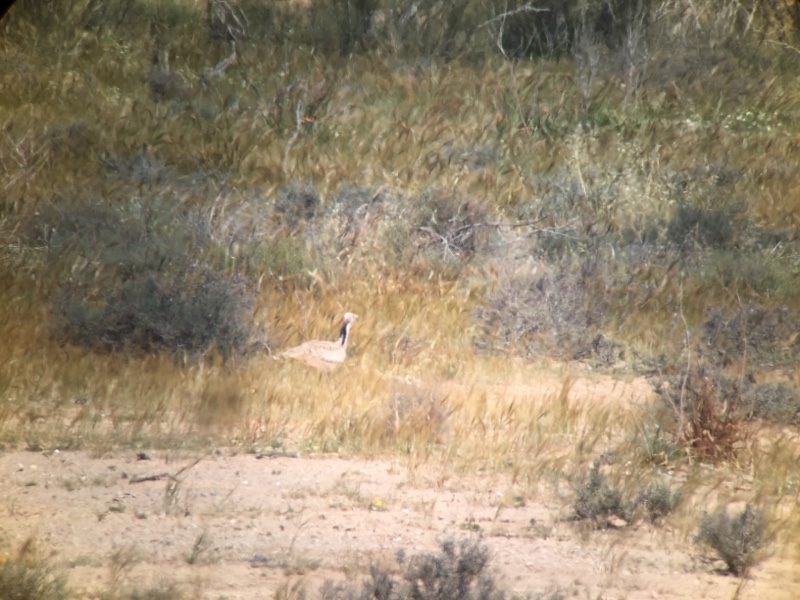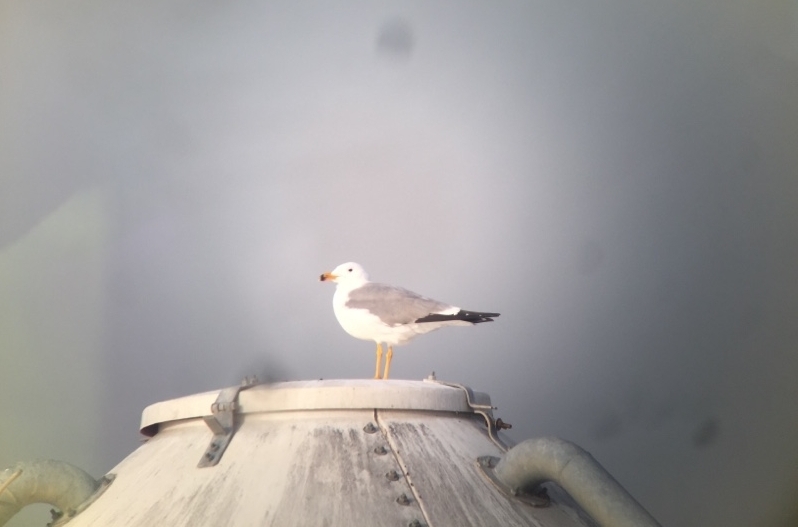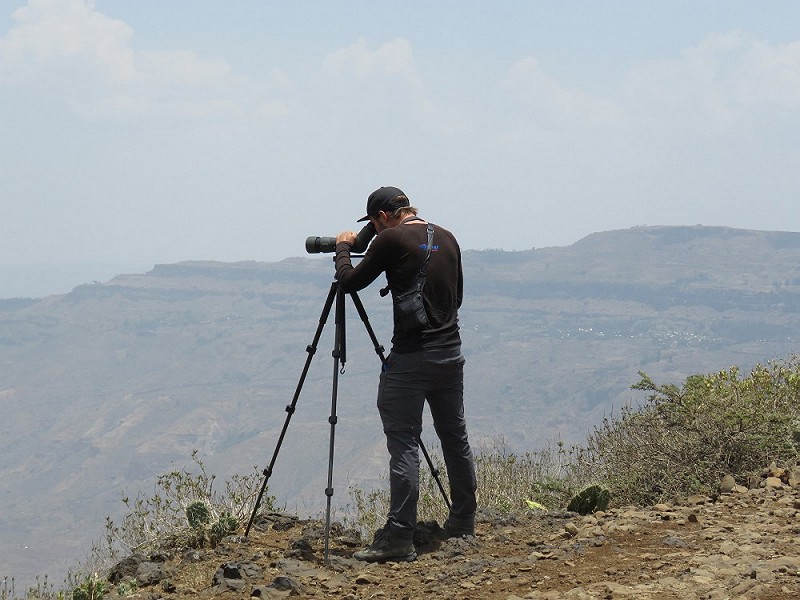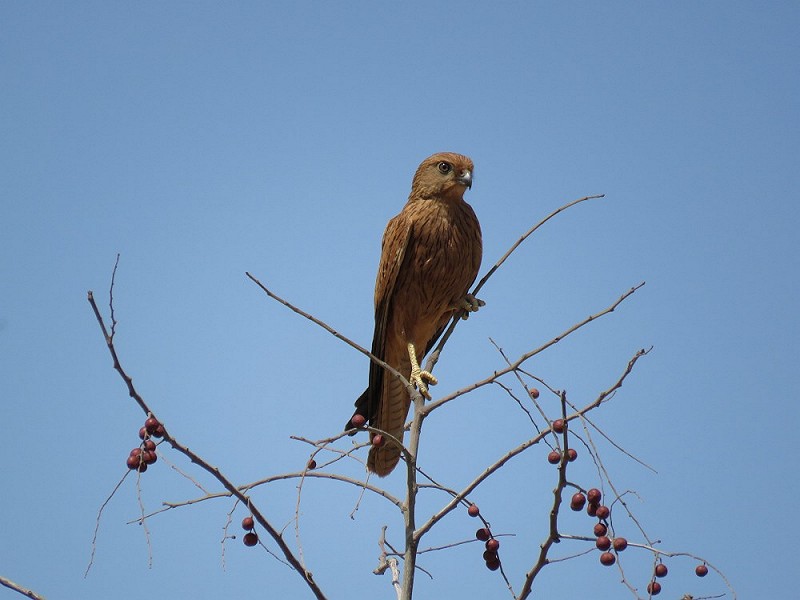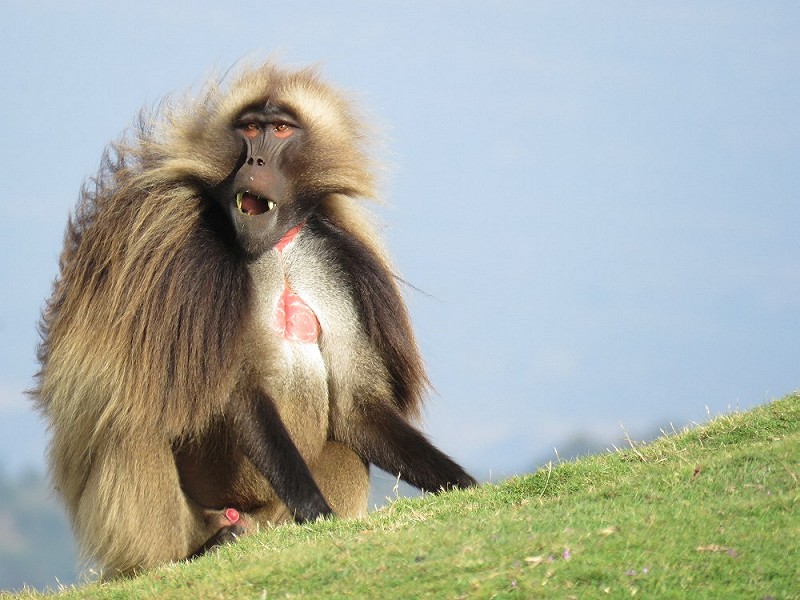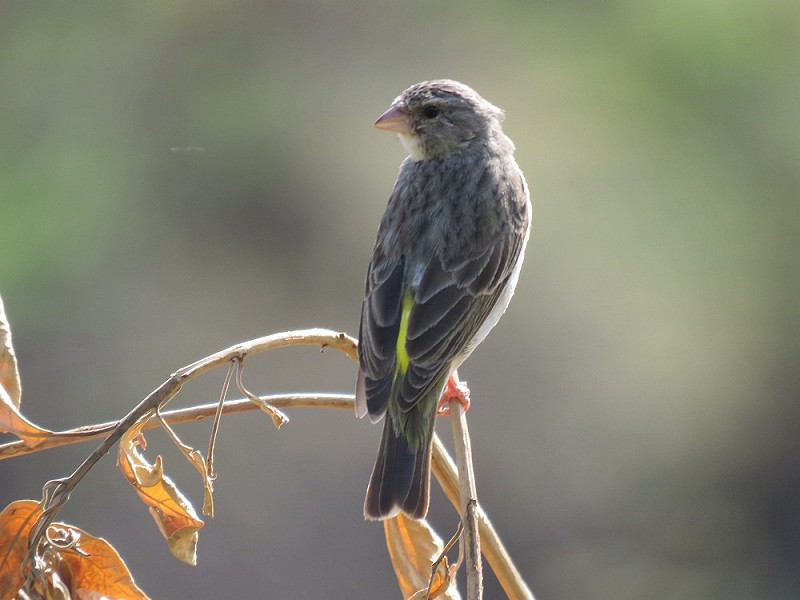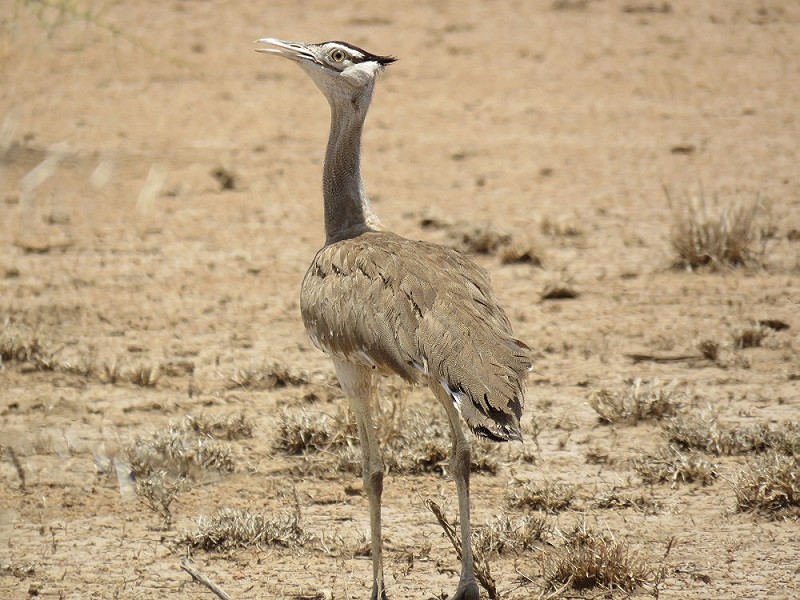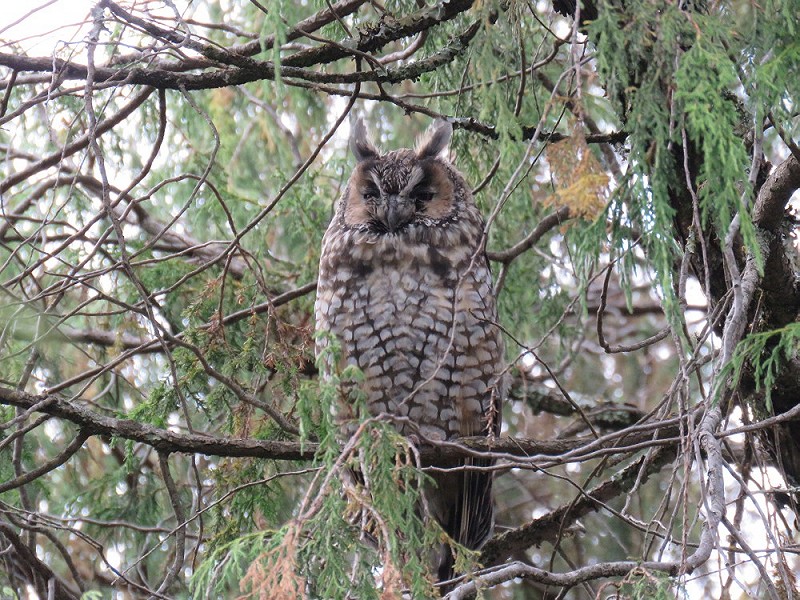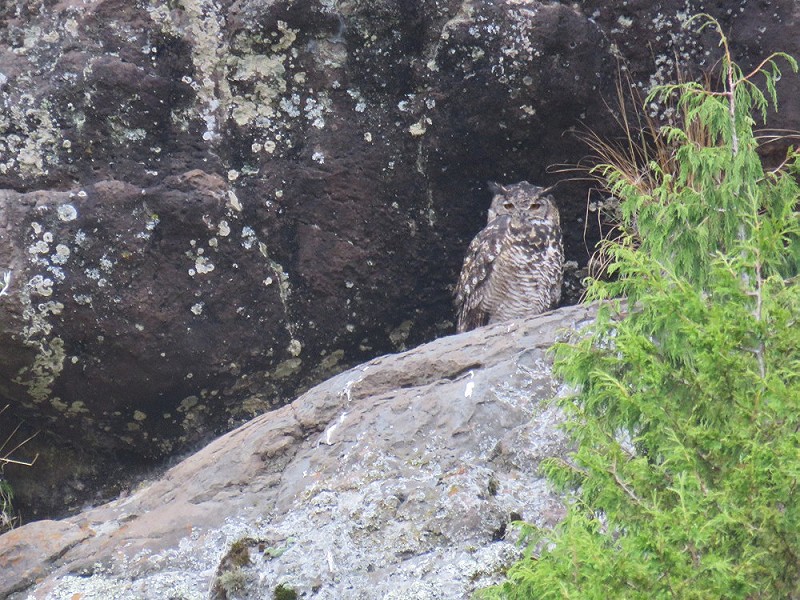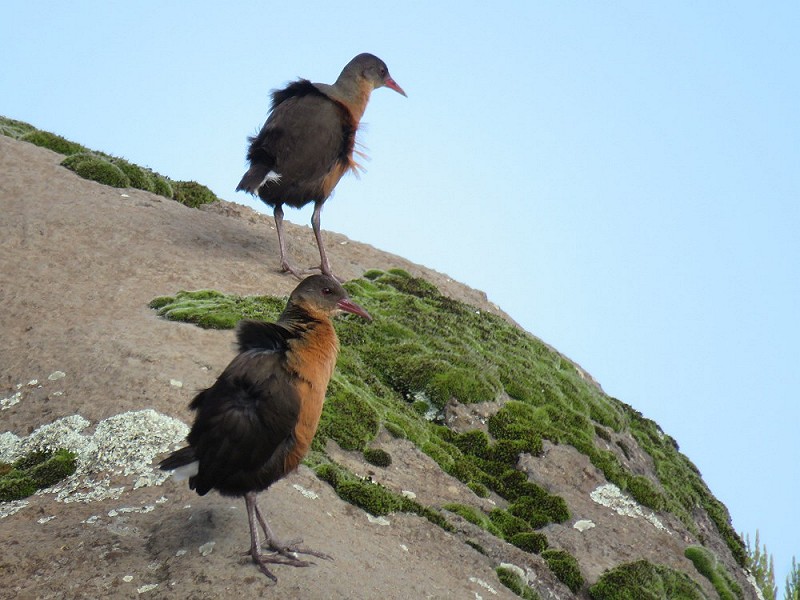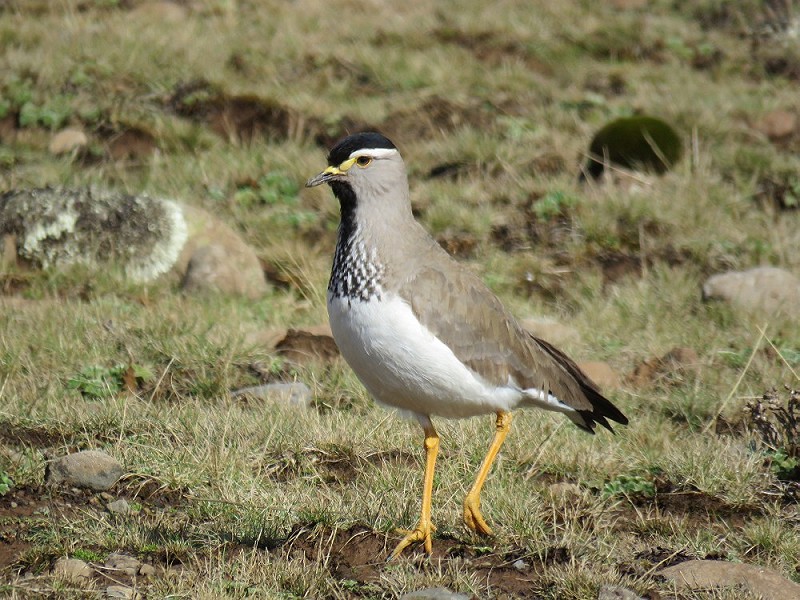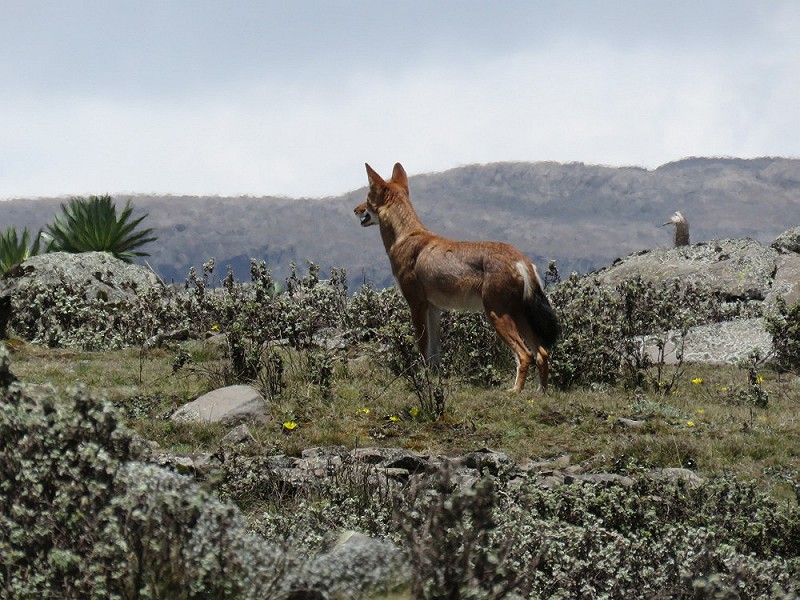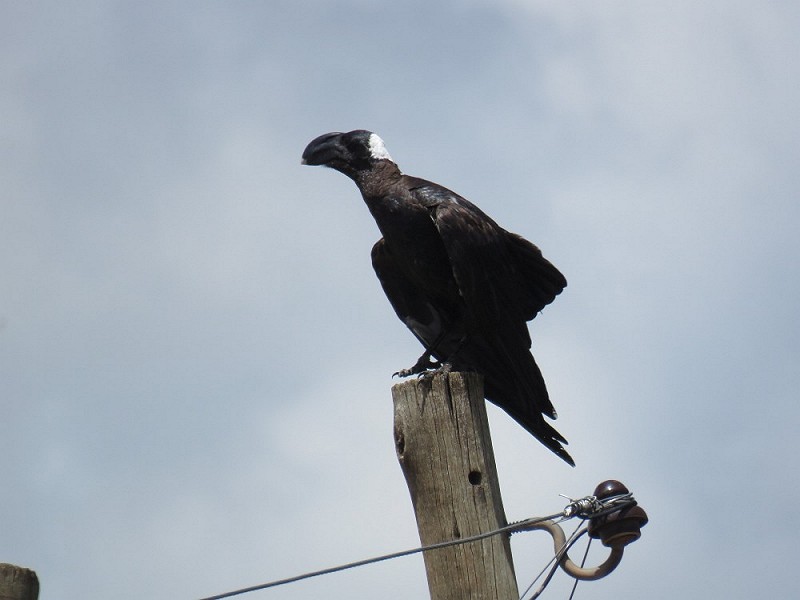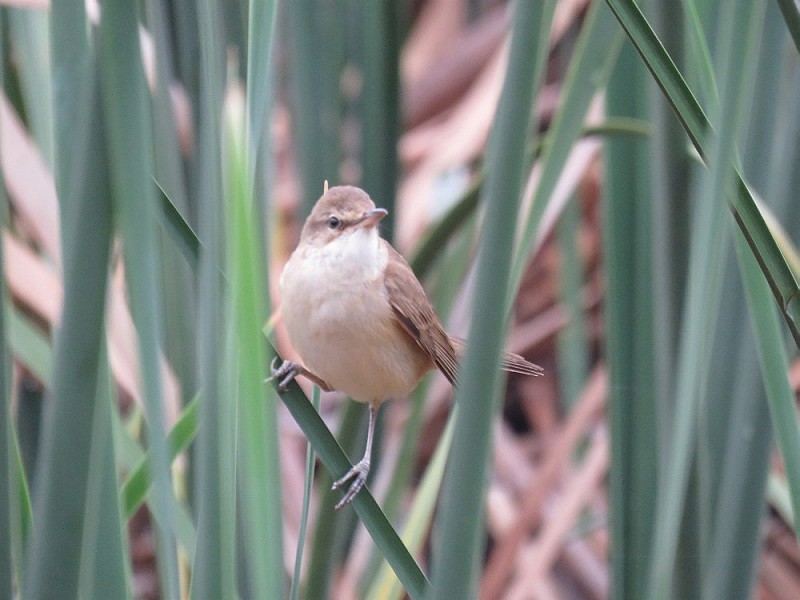April 3 - 13
15 April 2016 · Arjan Dwarshuis · 9957 × bekeken
PLEASE MAKE A DONATION NOW!
world.observation.org/arjan
www.arjandwarshuis.com/#biggestyear
April 3rd MIGRATION!
After a connecting flight via Tel Aviv I was met by local birder Itai Shanni and 3 Dutch friends at Eilat airport. No time to lose! We had just 2 hours left and within that short time we had to connect with all the main Eilat specialties. Jelle picked up my car while Itai and I drove down to the only known breeding site of the stunning Black Scrub-Robin in the whole of Israel.
Luckily Itai found the pair within 10 minutes after our arrival so we could drive south again. On the way we tried several sites for the uncommon Hooded Wheatear and at the 3rd attempt we hit the jackpot! Unbelievable that I got these two mega birds as my first two new ones in Israel!
Just before dusk we arrived at South Beach where we - after some scoping – connected with White-eyed Gull and Brown Booby. Another absolute highlight were the Steppe buzzards and White Storks coming in from the Red Sea, Eilat truly is the migratory hotspot of the Western Palearctic. All targets were secured so now we had time for a stroll through the bird observatory park. Again this was very productive with a stunning 2nd year male Semicollared Flycatcher and a female Little Crake.
We gave it our upmost spotlighting for Egyptian Nightjar and Pharaoh Eagle Owl, but both these species proved elusive.
Next we drove back to the airport where we picked up Oz Horine who had flown all the way from Tel Aviv to join me tomorrow on my road trip through the desert, what a gesture!
April 4th DESERT BIRDING
After spending the night at one of Oz’s relatives in a village north of Eilat we were out in a wadi at the crack of dawn. Our target was the rare and range restricted Arabian Warbler. Changes were slim, but against all odds we managed to find this star bird within half an hour after our arrival.
And so began our long birding journey north towards Tel Aviv, with yours truly as the driver! Our next stop was also at a wadi, but this time we tried for Thick-billed Lark, one of those other desert-gems that can be very elusive at times. Not this time! We found a female of this adeptly named species blending in perfectly with its desert surroundings.
Next up was one of my most wanted species, the Macqueen’s Bustard, but not before we found Bar-tailed Lark and Spectacled Warbler during two separate roadside stops.
We arrived at the site in the heat of the day, not ideal conditions to look for bustards. We started scanning the steppe-like landscape 360 degrees around us when suddenly I picked up a Macqueen’s Bustard creeping distantly through the low vegetation, fantastic! We managed to get a little bit closer and we even located a second bird.
The next birder who joined us was Meidad Goren, who took us out looking for migrants around the central part of Israel. By now it was scouring hot so we had to work hard to find any new species. The day before there were still up to 6 Collared Flycatchers around, but today there were none, I guess that’s the beauty of migration. We made the welcome decision to have a falafel lunch and cold cokes at a local restaurant since the lack of sleep and the driving through the heat started to take its toll on me.
For the afternoon and evening we were joined by legendary Israeli birder Yoav Perlman, the expert on the highly sought after Nubian Nightjar, but we had to wait for that cause we still had a couple of hours of precious daylight to kill before we could get on with the night birds. Also joining us was British birder Andy …..
Oz turned out to be an excellent crake-spotter and he managed to find me both a Spotted- and a Baillon’s Crake! Other highlights were nest building Dead Sea Sparrows and Sand Partridge.
Finally the sun set over the Dead Sea, the lowest point on earth (400 meters below sea level) and the search for Nubian Nightjar began. Tension rose as it gradually got darker, meanwhile we were stung to shreds by thousands of mosquitos. Suddenly both a male and a female bird started calling, but we couldn’t get the birds in our torches. Time was ticking so we decided to continue and try our luck for Hume’s – or Desert – Owl, luckily on the way over we stumbled upon a Nubian Nightjar in front of the car!
We stopped at a huge wadi, hopefully the Owl would call, but Yoav told us that he would be very surprised if we would even hear it let alone see it this time of the year. He hadn’t even finished his sentence when a Hume’s Owl started hooting continuously from the opposite cliff! Yoav started spotlighting for it and suddenly got eyeshine on a distant rock, Hume’s Owl! What a great finish, and luckily it was still before 10 PM because I still had a 2 hour drive to Oz’s place in Tel Aviv ahead of me…
April 5th TO THE SYRIAN BORDER AND BACK
After saying goodbye to Oz I drove in the direction of Mt. Hermon, Israel’s highest mountain and most northern tip of the country. At a village at the base of the mountain I met Nadav Israeli, the expert on Mt. Hermon’s birds.
The first bird we picked up on the mountain was immediately my most important target, the range restricted Syrian Serin. It was pleasantly common on the slopes of the mountain. Next up was Western Rock Nuthatch for which Nadav knew a nesting site. After finding my 9th Nuthatch this year with ease we drove to a territory of Sombre Tit, like many species reaching the most southern tip of their distribution on Mt. Hermon. Like the Serin and the Nuthatch we had no trouble finding this bird.
Around the top of Mt. Hermon we quickly found Crimson-winged Finch and the local race of Shore Lark, but the big surprise of the day was a pair of Pale Rock Sparrows.
From the top of Mt. Hermon we could look down into Syria, I stood still for a moment and considered myself a lucky man, doing what I love most while down there on the Syrian plains people are suffering….
On the lower slopes we found both Cretzschmar’s- and Ortolan Bunting and after that fantastic run we had the best falafel lunch in town.
Before I hit the road again we visited some ponds which held two pairs of Marbled Teal, my last new bird in the north.
To break up the long drive back to Tel Aviv I took a stop at some roadside ponds which held Armenian Gulls and a flock of Pygmy Cormorants.
And so came my 2 days and 2 hours of Israel to an end. Thanks to all the local birders and my Dutch friends helping me out along the way it was a huge success! Special thanks go out to Gert Ottens for arranging things from the Netherlands!
April 6th TOUCHDOWN IN AFRICA!
It was just starting to get light when I set foot on Ethiopian soil for the first time in my life. I love Africa and Ethiopia has been on top of my wish list of African countries to visit so naturally I was excited to finally be here! Merid, the founder of Birding Abyssinia, was already waiting for me along with his colleague Ashenafi and driver Biniem.
We had barely left the outskirts of Addis Ababa and there were already more than 20 new species on the Biggest Year list including several of the more common Abyssinian endemics.
Our first destination was Debre Libanos were we stayed in the Ethio-German Lodge. This place is fantastically situated right at the edge of the Jemma Valley.
We did our first proper birding around the old Portugese Bridge where we saw our first White-winged Cliff-chat and Ruppell’s Chat, meanwhile Lammergeiers, Ruppell’s- and White-backed Vultures drifted overhead.
The highlight at this site was a stunning male White-throated Robin quietly foraging under a low bush.
In the afternoon we went birding in a nearby remnant forest patch that proved very productive. For me the highlight was definitely an African Spotted Creeper, a bird that was very high on my wish list. Other good species were Ayer’s Hawk Eagle, Abyssinian Woodpecker, White-backed Tit and Banded Barbet.
I hit the sack at 7:30 PM to catch up with some much needed sleep after driving more than 800 kilometers through Israel in two days’ time.
April 7th BIRDING ALONG THE EDGE OF THE GREAT RIFT VALLEY
We left the Ethio-German Lodge at 5 AM and headed for the Jemma Valley. Our main target this morning was the endangered and highly localized Harwood’s Francolin. On the way over there we picked up a stunning female Pallid Harrier and several Erckel’s Francolins.
The scenery at the Harwood’s Francolin stakeout was absolutely breath-taking and it was hard to focus on birding with 50 kilometre views over the Jemma Valley.
It took some time, but after some searching we found the Francolins foraging on a field down in the valley.
As we descended further into the Jemma Valley we picked up a lot of new birds, a personal highlight was a pair of Abyssinian Ground Hornbill and the much smaller Hemprich’s Hornbill.
We stopped at a small stream that acted as a bird magnet since the surrounding countryside was bone-dry. I saw so many new birds that it was almost difficult to add all sightings on the spot!
Our main target here was the endemic Yellow-rumped Seedeater which Merid picked out brilliantly as it came to drink among a large mixed flock of Weavers, Bishops and Quelea’s.
On the way back up we found two Fox Kestrels, a species that I had missed many times before in Africa, so I was very pleased to finally see this stunning bird of prey.
After lunch we headed to Debra Birhan, a larger city on the Abyssinian plateau. From here we drove to Gemassa Gedel, right at the edge of the Great Rift Valley. This breath-taking viewpoint is also the stakeout for a rare Ethiopian endemic, the Ankobar Serin. Within 2 minutes after arrival Merid had already found a small flock of these drab looking seed-eaters, which meant that I could focus on filming a flock of Gelada’s, one of the largest and absolutely one of the most beautiful monkeys in the world. I am so happy that Ethiopia is part of my Biggest Year itinerary, what an amazing country!
April 8th THE LONG DRIVE TO AWASH
Today we had a very long drive ahead of us, all the way from Debra Birham to Awash National Park, but before we could commence with this day on the road we had to drive down into the Great Rift Valley to look for the Yellow-throated Seedeater, a poorly known Ethiopian endemic with a tiny range.
While making our way down we made a stop for breakfast at Ankobar, the old capital of Ethiopia. The Ankobar Serin was discovered near this city and now bears its name.
We arrived at the Yellow-throated Seedeater site around 9 AM and thanks to the Merid we’d found a pair within 5 minutes after our arrival! This meant that we would hopefully have some daylight left at the end of the day to look for the equally poorly known and range restricted Sombre Rock-Chat en route to Awash NP.
We stuck around for just a little longer at the Seedeater site since it was teaming with migrant passerines and within 10 minutes or so we found 4 Golden Orioles on their way to their northern breeding grounds!
8 long hours later we arrived at the lava plains near Awash, and thanks to Merids’ spot-on timing we had half an hour left to look for the Sombre Rock-Chat. Like with about everything so far we found the Chat within 5 minutes after arrival and even better, there were 5 birds around! A long, but satisfying day on the road!
April 9th BUSTARD BONANZA
Today we had a full day in Awash National Park, home of the Arabian Bustard. Awash is characterized by bone dry acacia Savannah reminiscent of the Sahel and it boast a wide range of dry zone birds that I would probably not find anywhere else during my Biggest Year. The park used to be good for big game as well, but over the course of the last decade lots of cattle herders settled in the park and subsequently big game numbers have dropped dramatically due to hunting and overgrazing. Unfortunately this is an increasingly regular phenomenon all across Africa and with a fast expending population it is bound to get a whole lot worse in the future.
I was lucky since it had rained heavily the last few days, this meant that birdlife was thriving and the park was alive with summer-plumaged weavers, northern migrants and resident species alike. Before breakfast I’d already recorded at least 30 new species and quite a lot of specialties, but the Bustard still played hard-to-get.
After breakfast we kept the pace going and among the new species noted were goodies like Lichtenstein’s Sandgrouse, Somali Bunting and White-bellied Bustard, but it was after clearing a bend in the road that the highlight of the day made its appearance, a stunningly huge Arabian Bustard! What as fantastic species! For good comparison this sighting was followed barely 5 minutes later by a huge male Kori bustard, the biggest flying bird in the world.
After lunch we went to the northern, more vegetated part of the park to take a walk through the bushveld. This must have been one of the birdiest places I’ve been so far this year and subsequently we picked up a lot of new things like Abyssinian Scimitarbill, Red-faced- and Northern Crombeck and Buff-bellied Warbler. In addition to these avian highlights we saw a stunning pair of Lesser Kudu, a species of antelope that I’ve been longing to see for quite some time now.
April 10th THE OWL MAN OF THE BALE MOUNTAINS
We left Awash NP early morning and headed for the Bale Mountains. This drive takes roughly all day so naturally birding was a bit slow en route, I did however see my first Thick-billed Ravens, what a humongous beast!
We were going as fast as we could so we would make it in time to the Bale Mountain NP and my appointment with Mister Abdela Hassa, the owl man of the Bale Mountains. Mr Abdela earned this name since he specializes in finding 3 fantastic owl species, the African Wood Owl, the ‘Dillonii’ ssp. Of Cape Eagle Owl and best of all the highly sought after Abyssinian Owl. A walk with this friendly man through the beautiful Podocarpus forest of Bale is supposedly a very special experience and I was looking forward to meeting him.
We arrived an hour before dusk and since there was no time to loose Mr. Abdela took me straight into the forest. After 10 minutes of walking through the forest we stopped and Mr Abdela pointed up at a huge Podocarpus and there sat a beautiful Abyssinian Owl!
Now that my most important target was in the pocket we continued on a bit more leisurely pace to our second target, the Cape Eagle Owl. This huge owl favours a rocky gorges further down the valley.
Mr Abdela looked a bit worried, the owl was obviously not at its favoured spot, but those worries soon disappeared when I found a stunning Cape Eagle Owl sitting on a rock face on the opposite slope.
Now there was one owl still missing, the African Wood Owl, but we had to hurry since light was fading rapidly. Luckily we arrived just in time to see a fantastic juvenile Wood Owl looking down on us, nice! All three Owl in the bag!
When we got back to the road there was a sudden movement to the right of us, it appeared to be two Golden Jackals, but as soon as I got my bins on them I realized that these things were far more reminiscent of Wolfs! They were much larger and greyer than any Golden Jackal I’d ever seen before and they appeared long-nosed and long-legged. I managed to shoot some footage of these animals before they disappeared, but it got even more exciting when they reappeared chasing a Reedbuck and its calf through the forest, they were hunting like wolfs would do, nothing like the scavenging Golden Jackal…
Back at the car Merid told me that this animal has recently been found to be the thought to be extinct Nubian Wolf, wow!
But it got even more exciting… Driving back to the hotel we suddenly saw two cats on the road. Wait a minute, these things are way too large and long-legged for housecats! And there was one of my nemesis African mammals, they were two Caracals! What a finish!
April 11th IN SEARCH OF THE ETHIOPIAN WOLF
What a luxury! I had breakfast at 7 AM today. I had the opportunity to sleep late today since it doesn’t get active on the Bale plateau – above 4000 meters – until it has warmed up a bit.
Just for the fun of it and because I’m used at waking up early, I made a short morning walk around the hotel gardens. Best was another Thick-billed Raven, I just can’t get enough of these amazing beasts!
As we drove up towards the plateau the scenery got better and better and at one point I wondered if this was the most amazing view I’d ever seen.
When we entered the vegetation zone above 3500 meters – reminding me of Andean paramo or puna – we entered the zone for todays’ targets. On the bird front these were Moorland Francolin and Spot-breasted Lapwing and on the mammal front it was Ethiopian Wolf. Merid and I had made an agreement that we would not descent until we’d found all three J
Of course the first sightings of Francolins were all Chestnut-naped-, but after some searching we found a covey of Moorland Francolins right next to the car! The Lapwing was a piece of cake and they seemed to be present all over the plateau, a good thing since this must surely be one of the more beautiful waders in the world.
Now there was one big thing still missing, the Wolf! After 2 hours of scanning there was still no sign of any Ethiopian Wolf – we did get a very lucky sighting of an adult Saker Falcon, a very unexpected find –so I started to get a little worried. Luckily Merid kept his head cool and suddenly asked me: ‘How bad do you want to see that wolf’? Meanwhile pointing laconically at 10 o’clock. And there was an Ethiopian Wolf! Surely one of the coolest mammals ever. Unfortunately they are also extremely rare due to habitat destruction and hunting and their numbers are down to less than 500 animals… What a privilege to see this stunning canine in the wild! And it got even better cause 10 minutes later we had another individual much closer by.
After descending and having lunch we went back to visit Mr Abdela for another round through the forest. We didn’t get that much as last time, but singing Abyssinian Catbird and Abyssinian Ground-thrush were very nice additions to the list.
April 12th TO LAKE AWASSA
First thing on the agenda this morning was Abyssinian Longclaw, a stunning bird that we readily found at Merid’s excellent stakeout. After that early success we started heading for Lake Awassa. En route we had an exciting encounter with a large flock of Vultures right next to the road, among them were no less than 7 Lappet-faced Vultures and 2 White-headed Vultures. If I’m not mistaken both these species are now listed as critically endangered due to the wide use of diclophenac in Africa. The same happened the last two decades with all the Indian Vultures. It would be terrible if we would lose these majestic birds forever cause what would Africa be without its Vultures?
Around lunchtime we arrived at our hotel right on the shore of the lake and after having lunch and uploading my blog and checking my email – I had no Wi-Fi the last couple of days – Merid and I went birding along the edge of the lake.
We found a lot of great stuff, but best were probably Green-backed Honeybird and an occupied nest of African Spotted Creeper with two young! We worked hard on trying to find a Basra Reed Warbler, but we could only pick out Great Reed Warblers, Lesser Swamp Warblers and Little Rush Warbler. The shore of the lake was swarming with people so all the shyer swamp species had to wait for tomorrow morning.
April 13th MY LAST DAY IN ETHIOPIA, BETTER MAKE IT COUNT!
As the sun rose over Lake Awassa I was birding along the shoreline, this time it was nice and quiet and the marshy edges of the lake were teaming with birdlife. There were nice numbers of African Pygmy Goose and white-backed duck around and I found both Allen’s Gallinule and African Swamphen in the reeds. Best was a stunning Lesser Jacana that Merid brilliantly picked out as it foraged actively across lilies and reeds.
But we were on a mission, it was the time of the year and the place to find Basra Reed Warbler so we gave it our best to pull one out of the reeds. After seeing several Swamp Warblers and Rush-warblers we suddenly saw a large greyish Reed-warbler with a strikingly long narrow bill popping up and simultaneously we yelled ‘Basra’! We had stunning views of the bird and I even managed to take a series of photographs. Mission accomplished!
Walking back to the hotel we found a flock of the uncommon Cuckoo-finch which allowed for fantastic scope views.
After breakfast we headed to the Wondo Genet forestry university grounds which boast a nice track of rainforest. This the place to be for the endemic Yellow-fronted Parrot. We were joined by Nuru, the sharpest eyes in Wondo according to Merid.
Indeed he was very sharp and despite the rain we found some nice things like Broad-billed Roller and Scaly Francolin, but it took us till after the rain had stopped before we could finally connect with a nice flock of Yellow-fronted Parrots.
And then it was time for the long drive back to Addis Abeba. My last new bird in this amazing country were two Black Crowned Cranes foraging along the roadside. A great finish to a highly successful 8 days in Ethiopia!
PLEASE MAKE A DONATION NOW!
world.observation.org/arjan
www.arjandwarshuis.com/#biggestyear


